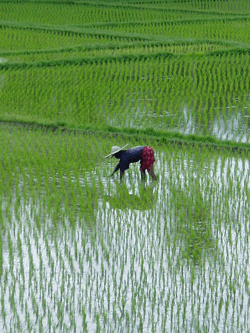
“Rice is a beautiful food. It is beautiful when it grows, precision rows of sparkling green stalks shooting up to reach the hot summer sun. It is beautiful when harvested, autumn gold sheaves piled on diked, patchwork paddies. It is beautiful when, once threshed, it enters granary bins like a (flood) of tiny seed-pearls. It is beautiful when cooked by a practiced hand, pure white and sweetly fragrant.”
– Shizuo Tsuji
Half of the world’s population eats rice daily.
It has been a staple food for centuries in many cultures around the globe providing an essential source of carbohydrates, minerals and vitamins. Since its domestication about 8,000-9,000 years ago, this grain has played a crucial role in developing civilizations and feeding their populations. Oryza sativa is the rice variety that is predominantly farmed and consumed worldwide, but thanks to genetic engineering, genomics (the genomes of 3,000 rice strains were recently sequenced and published), and selective breeding programs, new varieties are emerging to help tackle agricultural challenges such as drought in Africa.

Most of the global rice supply is produced and consumed in Asia, however, it is Africa where the fastest growth rate of consumption is taking place. Currently, Africa cannot meet its consumption levels and must import the rest primarily from Asia. Western African countries like Nigeria are leading the efforts to change this and are investing significantly to increase rice production; it is estimated that Nigeria will meet its internal demand by 2016.
Despite its unquestionable nutritional value, rice has a dark little secret: it can accumulate various metals (including mercury, lead and cadmium) and it is particularly susceptible to accumulation of arsenic from water and soil. Arsenic is a natural component of the Earth’s crust, generally found in trace quantities. However, concentrations may be higher in certain areas due to natural conditions or human activities. Arsenic is very similar to silicon and phosphate, two important nutrients for plant development, allowing it to be absorbed the same way. After absorption, arsenic accumulates in several plant tissues. In the grains themselves, most arsenic is found in the husk (left intact in brown rice), however, arsenic accumulates throughout the grain and represents a concern for populations that rely on rice as a staple food.
In a living organism, arsenic causes toxicity through inhibition of the pyruvate dehydrogenase (PDH) complex, an essential metabolic enzyme, which catalyzes the oxidation of pyruvate to acetyl-CoA by NAD+. This enzymatic inhibition disrupts the cellular energy system resulting in cellular suicide (apoptosis). Biomedical studies have linked chronic arsenic exposure with heart disease, stroke, lower respiratory disease, diabetes, and several types of cancer. Trace levels of arsenic can be detected in biological samples through a variety of instrumental techniques including atomic absorption spectrometry (AAS), atomic fluorescence spectrometry (AFS), inductively coupled plasma atomic emission spectrometry (ICP-AES), inductively coupled plasma mass spectrometry (ICP-MS) and voltammetry.

Not all rice strains accumulate arsenic the same way. Researchers in the United States found that certain varieties accumulate 20-fold less arsenic than others. Genetic testing performed to understand this by breeding high-arsenic with low-arsenic varieties suggest that a single gene is involved in the trait as a simple Mendelian ratio emerges from the cross. Which gene is responsible for it is still a mystery.
Two ways to interfere with arsenic in rice deal with how it is grown and processed:
- Cultivating the grain in dry soils and allowing only rain to water the plantations reduces the arsenic load by a factor of 30 compared with traditional flooded rice paddies. But unfortunately this approach is not always possible, particularly in waterlogged lowlands like most of Bangladesh.
- Processing of the grain to remove the husk (also known as milling) which turns brown rice into white also removes a significant portion of the arsenic along with many beneficial nutrients like fiber and niacin.
For the average individual, the best way to remove arsenic from rice is to use three times more water than grain, and rinsing before and after cooking. This can reduce the amount of arsenic by up to 30%.
However, don’t fret. The average concentration of arsenic in rice grown in the United States is approximately 260 ppb (arsenic levels can be as high as 900 ppb in other areas of the world). To give yourself arsenic poisoning you would have to consume over 200 kg of rice in one sitting! The biggest concern is populations who rely on rice as a daily staple, chronically exposing themselves to elevated levels of arsenic. So sit in peace knowing that you can enjoy your fresh salmon nigiri, just maybe don’t over-do it ok?
The atomic absorption spectrometry is able to detect food toxins, food borne illness, pesticides, herbicides, and other contaminates.
Click to learn more about this spectrometer.
“Don’t dunk your nigiri in the soy sauce. Don’t mix your wasabi in the soy sauce. If the rice is good, complement your sushi chef on the rice.”
– Anthony Bourdain


